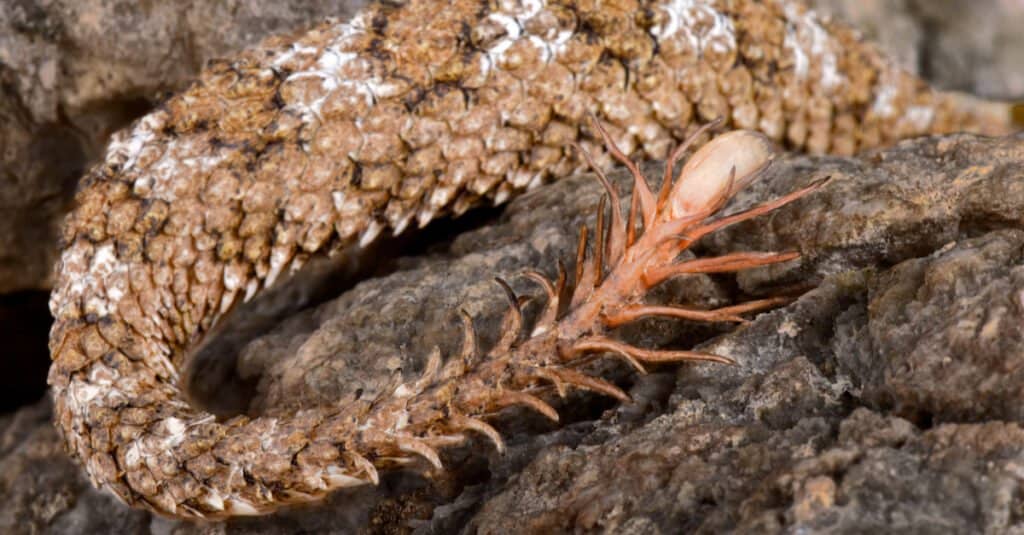Spider-Tailed Horned Viper
Pseudocerastes urarachnoides
They like to hide in crevices on the sides of cliffs, waiting for prey.
Advertisement
Spider-Tailed Horned Viper Scientific Classification
- Kingdom
- Animalia
- Phylum
- Chordata
- Class
- Reptilia
- Order
- Squamata
- Family
- Viperidae
- Genus
- Pseudocerastes
- Scientific Name
- Pseudocerastes urarachnoides
Read our Complete Guide to Classification of Animals.
Spider-Tailed Horned Viper Conservation Status
Spider-Tailed Horned Viper Facts
View all of the Spider-Tailed Horned Viper images!

With the finesse of a fly-fisherman, the spider-tailed horned viper lures its feathered prey to its doom.
The spider-tailed horned viper is a venomous snake that inhabits a small area in western Iran. Scientists first discovered it in 1968 but thought the tail was a random mutation. Yet, it was 2006 before scientists had a live specimen to examine and determined that the unique tail indicated they had a new species.
Spider-Tailed Horned Viper Amazing Facts

The tail of the snake (Pseudocerastes urarachnoides) has the appearance of a spider and is used to lure unsuspecting birds or other prey within reach of the viper.
©reptiles4all/Shutterstock.com
The spider-tailed horned viper, also known as the Persian horned viper, is a species of venomous snake that inhabits the western Iranian plateau. As the name suggests, this unique serpent possesses a distinctive spider-like tail tip, which it uses to lure unsuspecting prey into striking distance.
While it may not be the largest or deadliest species of snake, the spider-tailed horned viper has several fascinating features and behaviors that make it an incredible animal to study.
- The species uses a caudal lure (the tail!) that looks like a spider – a phenomenon known as feeding mimicry.
- These vipers blend into their environment well enough that birds land on them, so focused on the “spider” that they do not see the snake until it’s too late.
- They can strike in .2 seconds.
- Many of the local birds have figured out the viper’s game – it appears that only the visiting birds fall prey to its charms.
Evolution and Origins
The spider-tailed horned viper is a poisonous serpent that lives in a limited area of western Iran, which was first identified by researchers in 1968, who initially believed that its unique spider-like tail was a random genetic mutation.
Belonging to the Viperidae family and Pseudocerastes genus, the spider-tailed horned viper (Pseudocerastes urarachnoides) is a venomous type of viper, commonly referred to as “false-horned viper,” and is a native to the western part of Iran and adjacent areas of Iraq.
The most notable characteristic of the horned viper is its horns above the eyes, and these vipers can reach a maximum length of 33 inches. The horned viper’s coloration typically corresponds to its surroundings.
Location

The spider-tailed horned viper (Pseudocerastes urarachnoides) has a unique tail that has a bulb-like end and that is used to catch birds. It lives in Iran.
©reptiles4all/Shutterstock.com
They have only been found in a few areas in western Iran and are rare enough that CITES agreed to add them to Appendix II to restrict international trade.
The Persian horned viper, also known as the spider-tailed horned viper, is primarily located in the western regions of Iran and the eastern regions of Iraq, specifically in the Zagros Mountains, with a higher concentration on the western side of the mountain range; unfortunately, its distribution range is dwindling and relatively limited.
Scientific Name

©reptiles4all/Shutterstock.com
The spider-tailed horned viper, or Pseudocerastes urarachnoides, is part of the Viperidae family and means false horned, spider-like tail. Vipers are a family of venomous snakes with retractable fangs that inject venom deep into their prey. They are present in most parts of the world except Siberia, Ireland, the arctic circle, and Australia.
Pseudo = false
cerastes = false
ura = tail
arachna = spider
ides = like
The species was named by Steven Anderson, a biological expert specializing in South-East Asian reptiles. The scientist first stumbled on a specimen at the Field Museum of Natural History in Chicago and was fascinated by the arthropod-like lure at the end of its tail.
Population and Conservation Status
The IUCN listed it as “data deficient” because there isn’t enough data to determine whether they are threatened or endangered. Its range is small enough that there’s a concern among the scientific community. Scientists seek more information and want to have a more detailed study done.
Appearance and Description
These vipers are unique-looking. Their eyes are tan-colored with vertical pupils. They have rough skin with keeled scales that blends well with the granite of their home range; and scales that extend upwards from the eyes, forming “horns.” The most unique feature of the Spider-tailed Horned Viper is its tail: a bulbous, fleshy-looking end with long, thin scales that dangle from it.
Venom
It is venomous and will strike when threatened. However, it doesn’t seem to be aggressive towards people unless cornered. A study done by Brouw (2021) discovered that the venom of this species has a coagulating impact on humans and affects the X-factor; nevertheless, no incidents of human envenomation in their natural habitat have been documented, and the severity of the venom’s effects on humans remains unclear.
Behavior and Humans

©reptiles4all/Shutterstock.com
This viper is an ambush predator with a twist. It wiggles the end of its tail, making it appear alive. Its favorite food is of the feathered variety, and several videos show a spider-tailed horned viper luring a bird close enough to strike. However, it doesn’t restrict its diet to birds – the spider-tailed horned viper also hunts arthropods, rodents, and lizards.
People have become its most significant predators, and its unique hind end has attracted collectors.
Similar Animals
View all 293 animals that start with SSpider-Tailed Horned Viper FAQs (Frequently Asked Questions)
What are their natural predators?
We don’t know yet.
Do they hatch with that spider-shaped tail?
No, their tail develops into the lure as they grow.
Are they venomous?
Yes! Like all snakes in the Viperidae family, they are venomous.
How do they hunt?
They are ambush predators; they wait for their food to come to them. Then, using the spider-shaped tail, they wiggle it to make it look like a juicy bug.
Are spider-tailed horned vipers aggressive?
They don’t appear to be but will defend themselves if cornered.
Where do spider-tailed horned vipers live?
They live in the rocky, arid hills of western Iran.
What do spider-tailed horned vipers eat?
Their favorite food is birds, but they will also eat lizards, rodents, and arthropods.
Does their tail break off like rattlesnake rattles?
Not on purpose. Researchers reported seeing a few determined birds pecking hard enough to make off with the “spider,” leaving the snake to resort to other hunting methods.
Thank you for reading! Have some feedback for us? Contact the AZ Animals editorial team.
Sources
- IUCN / Accessed February 4, 2022
- CITES / Accessed February 4, 2022
- CITES / Accessed February 4, 2022
- The Reptile Database / Accessed February 4, 2022
- Herpetologica / Accessed February 4, 2022
- Research Gate / Accessed February 4, 2022
- Research Gate / Accessed February 4, 2022
- National Library of Medicine / Accessed February 4, 2022


















